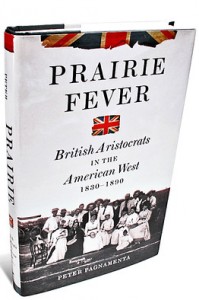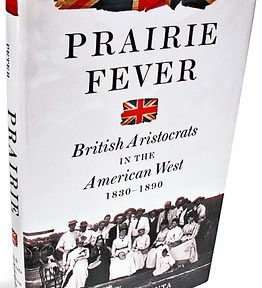 The British upper classes have long had a problem with their younger sons. The eldest son inherits, the daughters are married off, but what to do with the other boys? One answer was, ship ’em out. It was one of P.G. Wodehouse’s most joyous diversions to have feckless younger sons supplied with money from home on the condition that they go forth “to some blighted locality of the name of Colorado” to “pursue cows, and so forth.” One Wodehouse hero concludes plaintively that he is nothing but “a sort of valet to Uncle Frederick’s beastly sheep.”
The British upper classes have long had a problem with their younger sons. The eldest son inherits, the daughters are married off, but what to do with the other boys? One answer was, ship ’em out. It was one of P.G. Wodehouse’s most joyous diversions to have feckless younger sons supplied with money from home on the condition that they go forth “to some blighted locality of the name of Colorado” to “pursue cows, and so forth.” One Wodehouse hero concludes plaintively that he is nothing but “a sort of valet to Uncle Frederick’s beastly sheep.”
Peter Pagnamenta’s vivid retelling of the British gentry’s 19th-century dabblings in the American West shows that this New World destiny was not merely comedy. Unlike Wodehouse’s characters, most of Mr. Pagnamenta’s young men actively desired their “wilderness” years, which combined favored outdoor pastimes from home with new diversions like hunting bison. He tells us that Englishmen in Harper County, Kansas, put on the traditional “pink” hunting clothes and chased coyotes across the prairie.
The British had been devouring tales of the American wilderness since the 1820s appearance of James Fenimore Cooper’s “Leatherstocking Tales” of Indian warfare in the backwoods of New York. With “The Prairie” (1832), Cooper took his characters west, beyond the Mississippi, and introduced his English readers to the Great Plains (though he himself had never traveled west of Niagara Falls). In the 1840s, the painter and showman George Catlin toured Britain with a collection of Native American weapons, clothing and wigwams. From 1843, he was accompanied by nine Ojibwe who drew large crowds.
By this time a few venturesome Brits had begun to travel to the American West themselves: by steamboat to St Louis, then on by pack-train to the prairie expanses. William Drummon Stewart, a retired British army captain, arrived in 1832 and spent six years journeying through the west. He headed first to what is now Wyoming, where fur trappers and Native Americans traveled great distances for an annual summer rendezvous, a combination of fair, trading post and drinking bout.
On this trip, Stewart lived like a trapper, happily roughing it with minimal supplies. In his later journeys west, comfort and status ruled, and he took with him three servants and a range of wines and spirits. Charles Murray, son of the Earl of Dunmore, traveled through the plains in the 1830s with his valet and his dog, Peevish. (Mr. Pagnamenta excels in finding these telling details.) Sir St. George Gore went one better, making his tour complete with a brass bed, a bath and three cows to provide milk for his tea.
These early visitors were both aristocratic and wealthy, but as the pioneers’ wagons wore a route across the plains in the 1840s, it became less expensive to make shorter jaunts out to the prairies. British newspapers and sporting journals began to feature articles on what had become an “extensive hunting frolic,” where the hunters, according to one scandalized observer, shot for sport, not for meat. And the spread of the railways made such journeys even simpler. Now men could travel a few hundred miles out onto the prairies and be home in time for Christmas, with a good story to tell in their clubs.
Soon, however, the reasons for travel changed. Britain experienced a drastic agricultural slump, lowering the income of landowners. Dilettante aristocrats were soon replaced by men more intent on making a life, or at least a living, in the American West.
Most of the new arrivals were naïve to the point of foolishness. Some still spent wildly, bringing out British architects to design their houses or, in the case of the silk merchant George Grant, to plan an entire town in order to entice gentleman-farmers to buy property. Thomas Hughes, the author of “Tom Brown’s Schooldays,” founded a town, Rugby, in Tennessee (it survives), where immigrants, when not farming, played cricket and rugby and ran an amateur-dramatic society and a monthly magazine.
Some hopefuls put their money in beef. Federal law gave homesteaders with 160 acres grazing rights, and as long as cattle obtained high prices in the Midwest, they did well. In the 1880s, Lord Tweedmouth bought a ranch in the Texas panhandle for his younger son; Lord Airlie did the same in Colorado. But by 1884 prices for cattle were falling, the land had been over-grazed, and a summer of drought followed a ferocious winter just as farmers were enclosing what had previously been pasturage.
Many ranchers, both British and native-born, had used the same underhand methods to acquire land, but the idea of British aristocrats grinding the faces of valiant American homesteaders made a much better story. The Alien Land Bill passed in 1887, banning any foreigner not undergoing naturalization from buying land in the territories. The cattle boom was over. English lords began to look to places like Kenya and Australia for their younger sons.
In “Prairie Fever,” Mr. Pagnamenta tells this story with verve and style. His love of tales of derring-do on the prairie matches his subjects’, even as his exploration of the travelers’ successes and failures (mostly the latter) are models of sympathetic objectivity. His grip on British history and culture is less sure-footed: London’s “new” underground was in 1887 nearly a half-century old; Lord Althorp spells his name without an “e”; European notions of the Noble Savage derive not only from James Fenimore Cooper but also, and primarily, from Rousseau, whom Mr. Pagnamenta fails to mention.
But these niggles cause no harm in a book that is a constant delight. One British aristocrat had her expectations of the Wild West dashed when she arrived in Indian Territory to find four Native Americans taking part in a brisk game of croquet on the railway platform. A sight, surely, worth being a valet to your uncle’s sheep to see.
